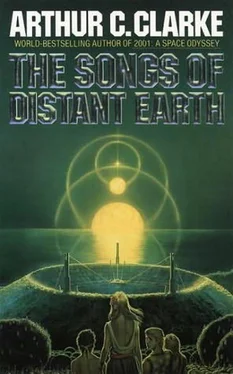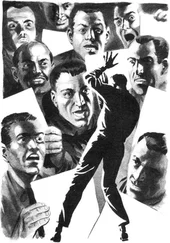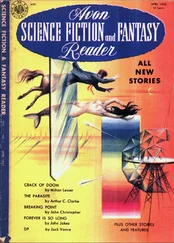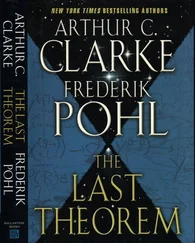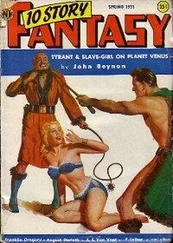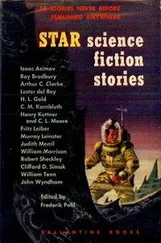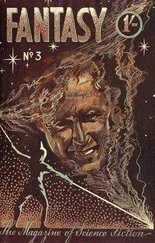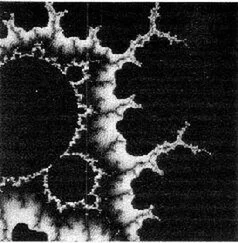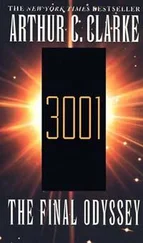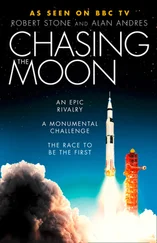“So then we will have a virgin planet, larger than Earth, with about forty percent ocean and a mean temperature of twenty-five degrees. The atmosphere will have an oxygen content seventy percent of Earth’s — but still rising. It will be time to awaken the nine hundred thousand sleepers still in hibernation, and present them with a new world.
“That is the scenario unless unexpected developments — or discoveries — force us to depart from it. And if the worst comes to the worst…”
Dr. Varley hesitated, then smiled grimly.
“No — whatever happens, you won’t be seeing us again! If Sagan 2 is impossible, there is another target, thirty light-years farther on. It may be an even better one.
“Perhaps we will eventually colonize both. But that is for the future to decide.”
The discussion took a little time to get under way; most of the Academicians seemed stunned, though their applause was certainly genuine. The president, who through long experience always had a few questions prepared in advance, started the ball rolling.
“A trivial point, Dr. Varley — but who or what is Sagan 2 named after?”
“A writer of scientific romances, early Third Millennium.”
That broke the ice, just as the president had intended.
“You mentioned, Doctor, that Sagan 2 has at least one satellite. What will happen to it, when you change the planet’s orbit?”
“Nothing, apart from very slight perturbations. It will move along with its primary.”
“If the directive of — what was it, 3500 — ”
“3505.”
“— had been ratified earlier, would we be here now? I mean, Thalassa would have been out of bounds!”
“It’s a very good question, and we’ve often debated it. The 2751 seeding mission — your Mother Ship on South Island — would certainly have gone against the directive. Luckily, the problem hasn’t arisen. Since you have no land animals here, the principle of noninterference hasn’t been violated.”
“This is very speculative,” one of the youngest of the Academicians said — to the obvious amusement of many of her elders. “Granted that oxygen means life, how can you be sure that the reverse proposition is true? One can imagine all sorts of creatures — even intelligent ones — on planets with no oxygen, even with no atmosphere. If our evolutionary successors are intelligent machines, as many philosophers have suggested, they’d prefer an atmosphere in which they wouldn’t rust. Have you any idea how old Sagan 2 is? It might have passed through the oxygen-biological era; there could be a machine civilization waiting for you there.”
There were a few groans from dissenters in the audience, and someone muttered ‘science fiction!” in tones of disgust. Dr. Varley waited for the disturbance to die away, then answered briefly, “We’ve not lost much sleep over that. And if we did run into a machine civilization, the principle of noninterference would hardly matter. I’d be much more worried about what it would do to ms than the other way round!”
A very old man — the oldest person Dr. Varley had seen in Thalassa — was slowly rising to his feet at the back of the room. The chairman scribbled a quick note and passed it over: ‘Prof. Derek Winslade — 115 — GOM of T. science — historian.’ Dr. Varley puzzled over GOM for a few seconds, before some mysterious flash of insight told her that it stood for ‘Grand Old Man’.
And it would be typical, she thought, if the dean of Lassan science was a historian. In all their seven hundred years of history, the Three Islands had produced only a handful of original thinkers.
Yet this did not necessarily merit criticism. The Lassans had been forced to build up the infrastructure of civilization from zero; there had been little opportunity, or incentive, for any research that was not of direct practical application. And there was a more serious and subtle problem — that of population. At any one time, in any one scientific discipline, there would never be enough workers on Thalassa to reach ‘critical mass’ — the minimum number of reacting minds needed to ignite fundamental research into some new field of knowledge.
Only in mathematics — as in music — were there rare exceptions to this rule. A solitary genius — a Ramanujan or a Mozart — could arise from nowhere, and sail strange seas of thought alone. The famous example from Lassan science was Francis Zoltan (214–242); his name was still revered five hundred years later, but Dr. Varley had certain reservations even about his undoubted skills. No one, it seemed to her, had really understood his discoveries in the field of hypertransfinite numbers; still less extended them further — the true test of all genuine breakthroughs. Even now, his famous ‘Last Hypothesis’ defied either proof or disproof.
She suspected — though she was far too tactful to mention this to her Lassan friends — that Zoltan’s tragically early death had exaggerated his reputation, investing his memory with wistful hopes of what might have been. The fact that he had disappeared while swimming off North Island had inspired legions of romantic myths and theories — disappointments in love, jealous rivals, inability to discover critical proofs, terror of the hyperinfinite itself — none of which had the slightest factual foundation. But they had all added to the popular image of Thalassa’s greatest genius, cut down in the prime of his achievement.
What was the old professor saying? Oh, dear — there was always someone during the question period who brought up a totally irrelevant subject or seized the opportunity to expound a pet theory. Through long practice, Dr. Varley was quite good at dealing with such interpolators and could usually get a laugh at their expense. But she would have to be polite to a GOM, surrounded by respectful colleagues, on his own territory.
“Professor — ah — Winsdale’ ‘Winslade’ the chairman whispered urgently, but she decided that any correction would only make matters worse, “the question you have asked is a very good one but should really be the subject of another lecture. Or series of lectures; even then, it would barely scratch the subject.
“But to deal with your first point. We have heard that criticism several times — it is simply not true. We have made no attempt to keep the secret, as you call it, of the quantum drive. The complete theory is in the ship’s Archives, and is among the material being transferred to your own.
“Having said that, I don’t want to raise any false hopes. Frankly, there is no one in the ship’s active crew who really understands the drive. We know how to use it — that’s all.
“There are three scientists in hibernation who are supposed to be experts on the drive. If we have to wake them up before we reach Sagan 2, we’ll be in really serious trouble.
“Men went insane trying to visualize the geometrodynamic structure of superspace, and asking why the universe originally had eleven dimensions instead of a nice number like ten or twelve. When I took the Propulsion Basics Course, my instructor said, “If you could understand the quantum drive, you wouldn’t be here — you’d be up on Lagrange 1 at the Institute for Advanced Studies.” And he gave me a useful comparison that helped me get to sleep again when I had nightmares trying to imagine what ten to the minus thirty three centimetres really means.
“Magellan’s crew only has to know what the drive does,” my instructor told me. “They’re like engineers in charge of an electric distribution network. As long as they know how to switch the power around, they don’t have to know how it’s generated. It may come from something simple, like an oil-fuelled dynamo or a solar panel or a water turbine. They would certainly understand the principles behind these — but they wouldn’t need to in order to do their jobs perfectly well.
Читать дальше
